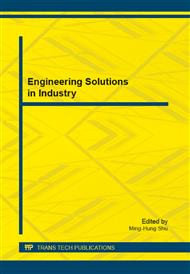[1]
S.W. Zhang, H.T. Zhang, A review of wireless sensor networks and its applications, IEEE Int. Conf. Autom. Logist., ICAL (2012) 386-389.
Google Scholar
[2]
W.J. Guo, W. Zhang, A survey on intelligent routing protocols in wireless sensor networks, J Network Comput Appl 38 (2014) 185-201.
Google Scholar
[3]
M. Li, Z.J. Li, V. Athanasios, A survey on topology control in wireless sensor networks: taxonomy, Proc. IEEE 101 (2013) 2538-2557.
DOI: 10.1109/jproc.2013.2257631
Google Scholar
[4]
P. Nikolaos A, N. Stefanos A, V. Dimitrios D, Energy-efficient routing protocols in wireless sensor networks: a survey, IEEE Commun. Surv. Tutor. 15 (2013) 551-591.
DOI: 10.1109/surv.2012.062612.00084
Google Scholar
[5]
H. Wendi R, C. Anantha, B. Hari, Energy-efficient communication protocol for wireless microsensor networks, Proc Hawaii Int Conf Syst Sci (2000) 223.
Google Scholar
[6]
H. Wendi B, C. Anantha P, B. Hari, An application-specific protocol architecture for wireless microsensor networks, J. Sci. Commun. 1 (2002) 660-670.
Google Scholar
[7]
X.H. Wu, S. Wang, Performance comparison of LEACH and LEACH-C protocols by NS2, Proc. - Int. Symp. Distrib. Comput. Appl. Bus., Eng. Sci., DCABES (2010) 254-258.
Google Scholar
[8]
E. Muzaffar M, L. Kevin E, R.A. Lupton, Optimization of water distribution network design using the shuffled frog leaping algorithm, J. Water Resour. Plann. Manage. 129 (2003) 210-225.
DOI: 10.1061/(asce)0733-9496(2003)129:3(210)
Google Scholar
[9]
P. Luo, Q. Lu, X.W. Chen, Modified shuffled frog leaping algorithm based on new searching strategy, Proc. - Int. Conf. Nat. Comput., ICNC 3 (2011) 1346-1350.
DOI: 10.1109/icnc.2011.6022273
Google Scholar
[10]
Y.P. Chen, Y.Z. Chen, A novel energy efficient routing algorithm for wireless sensor networks, Int. Conf. Mach. Learn. Cybern., ICMLC 2 (2010) 1031-1035.
Google Scholar
[11]
X. Zhu, Y.L. Zhang, Wireless sensor network path optimization based on particle swarm algorithm, Proc. - IEEE Int. Conf. Comput. Sci. Autom. Eng., CSAE 3 (2011) 534-537.
Google Scholar
[12]
S. Rahnamayan, H.R. Tizhoosh, M.M. A Salama, Opposition versus randomness in soft computing techniques, Appl. Soft Comput. J. 8 (2008) 906-918.
DOI: 10.1016/j.asoc.2007.07.010
Google Scholar
[13]
J.G. Jiang, Q. Su, M. Li, An improved Shuffled Frog Leaping Algorithm, J. Inf. Comput. Sci. 10 (2013) 4619-4626.
DOI: 10.12733/jics20102191
Google Scholar
[14]
B. Li, Z.F. Zhang, Y. S. Zhang, An improved SFLA based on inner-memeplex crossover and Gaussian mutation, Intl. J. Adv. Comput. Technolog. 4 (2012) 47-52.
DOI: 10.4156/ijact.vol4.issue17.6
Google Scholar


